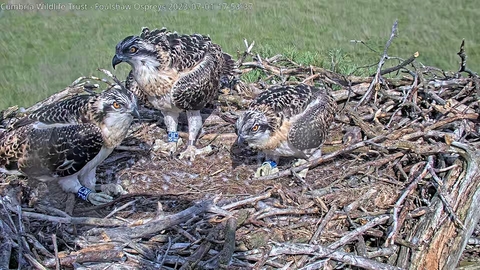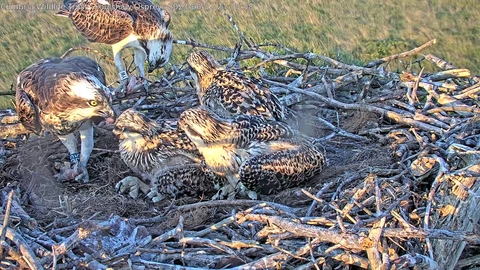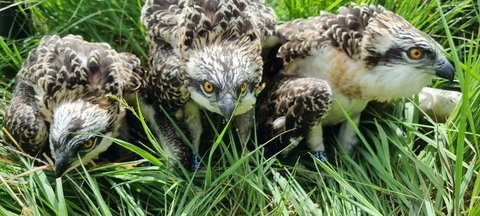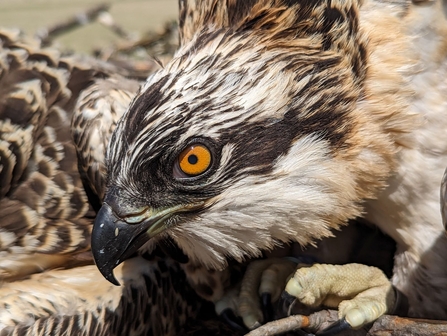On Saturday 1 July, an experienced and licensed bird ringer visited Foulshaw Moss and carefully took the young ospreys from the nest, lowering them to the ground for about thirty minutes while they were checked over, tagged, weighed and measured.
This is the only time that we intervene in the lives of the ospreys and it's an important role in helping the conservation of the species. While the young were being checked, the parent birds were circling overhead, keeping an eye on procedures: they probably know what to expect now after nearly ten years of rearing young at Foulshaw.
Due to increasing cases of avian influenza across the country we've been following guidance from the British Trust for Ornithology (BTO) while carrying out our ringing operation this season. Although ospreys are considered low risk for the disease, it's always best to put procedures in place to mitigate any risk.

© Cumbria Wildlife Trust
The young ospreys back on the nest after ringing. From left to right: 8C2, 8C3 and 8C1.
What we learnt about the three chicks during the ID ringing procedure:
Darvic ring ID: 8C1
Sex: Male
Wing length: 310mm
Weight: 1450g
Darvic ring ID: 8C2
Sex: Female
Wing length: 355mm
Weight: 1520g
Darvic ring ID: 8C3
Sex: Female
Wing length: 350mm
Weight: 1730g

© Cumbria Wildlife Trust
Blue 35 and White YW with Darvic rings on their right legs
Why do we tag and ring the ospreys?
Bird ringing provides information on the survival, productivity and movements of birds, helping us to understand why populations are changing.
The ospreys receive two rings. One is a metal British Trust for Ornithology (BTO) ring which is part of the National Bird Ringing Scheme. This ring contains a unique number to identify the bird as well as contact details so that it can be reported if it’s found.
The other, larger ring is called a Darvic ring (named after the strong plastic material that it’s made of). It’s placed on the other leg and has a background colour with large contrasting letters or numbers on it – hence Blue 35 and White YW.
The Darvic ring can been read through binoculars, telescope or telephoto camera and can help to identify the bird either in flight, visiting a nest or roosting in its wintering grounds.
Both rings are really valuable to help us follow birds at their nests and to build up knowledge on lifetime reproduction. It means that we can find out whether our birds return to their natal area; identify the origin of new birds (intruders) in the area and build up records on mating partners and brood success rates.
It lets us study how many young birds leave the nest and survive to become adults, as well as how many adults survive the stresses of breeding, migration and severe weather.

@ Cumbria Wildlife Trust
What do Darvic rings tell us?
Conservationists began identifying and ringing ospreys in 1966. Since then over 3,000 birds have been ringed: initially just in Scotland and, as the ospreys have dispersed, more recently in Wales and England.
The first Scottish rings contained one letter or number. As the number of ospreys increased, so did the digits on the rings and some ospreys are now identified with three letters or numbers.
In more recent years Darvic rings in Scotland have been placed on the left leg and those in England and Wales on the right leg.
Across Europe different countries have now adopted different colours for ringing ospreys. The UK uses Blue rings, Germany uses Black, France uses Orange and Spain uses Yellow. White YW was ringed 15 years ago before the new practice came into force!

The 2023 Foulshaw osprey chicks wearing their newly fitted ID leg rings in June: Two females and one male, Foulshaw Moss Nature Reserve © Cumbria Wildlife Trust
When is the best time to ring ospreys?
Osprey chicks are normally ringed at around five weeks old. At this point in their lives they are almost fully grown and their legs are sturdy: this means the rings will fit well.
The youngsters haven’t yet fledged which means they can be handled in the nest and won't fly away.
The parent birds have also built a strong bond with their offspring so they won’t desert the young when humans approach.
Read our March blog which lists the previous 24 Foulshaw chicks, some of which we were lucky to have seen since their migration.

© Cumbria Wildlife Trust
The chicks' next milestone
In the next few weeks the young ospreys will be fledging. Watch them on the live osprey webcam as they strengthen their wings and learn the skills needed to take off.
And hold your breath as they helicopter upwards.... and hopefully land safely back in the nest again. I wonder when the first youngster will fledge?
8C2-demonstrating-flying-lessons (https://youtu.be/6oAPfClKjak)
© Cumbria Wildlife Trust
Watch the short clip (via YouTube) of Blue 8C2 showing her siblings the art of learning to fly.


Comments